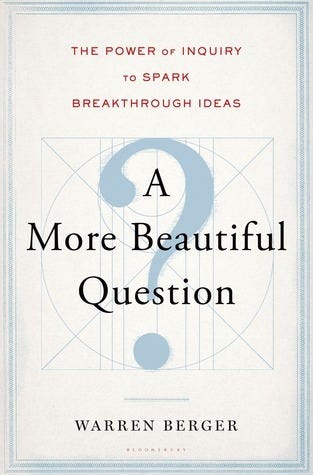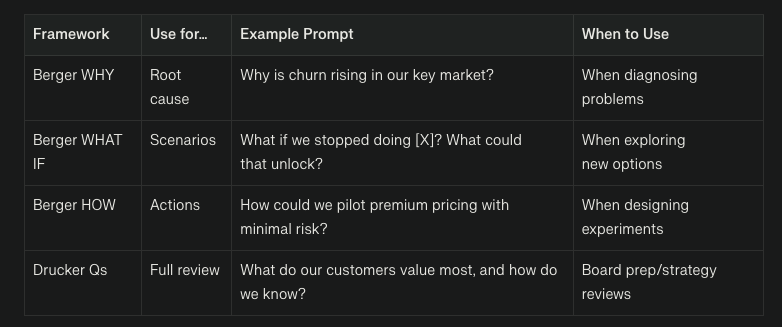Turn Executive Frustration Into Strategic Breakthroughs: Use Berger’s & Drucker’s Frameworks as AI Game Changers
Frustrated by AI that answers your strategic questions with the same recycled ideas? Many leaders today are hitting a wall: generative AI is everywhere, but it feels like pulling teeth to get genuinely insightful advice. Hours spent refining prompts and outlining context often lead to more of the same—glossy summaries with little depth. Yet, world-class strategic thinking always starts with asking better questions, not choosing fancier tools. What if you could instantly transform the best frameworks in business strategy into working prompts, unlocking AI as a real thought partner?
Why Berger’s “A More Beautiful Question” Matters
Warren Berger’s book, “A More Beautiful Question”, argues that breakthrough innovation starts not with answers, but with the quality of the questions we ask. Berger breaks strategy down to three recurring types: “Why?”, “What if?”, and “How?”. He shows that asking Why exposes root problems, What if inspires new possibilities, and How gets us down to practical action. This approach has powered startups, helped turnaround organisations, and underpins some of the century’s most innovative cultural shifts.
Rather than relying on questions as philosophical exercises, Berger wants readers to treat questioning as a daily executive toolkit. In the AI age, this means every Why, What if, and How can become a prompt—directing the AI to think more like an advisor and less like a copywriter.
Drucker’s Five Timeless Leadership Questions
Peter Drucker, often called the founder of modern management, focused obsessively on clarity and fundamentals. His “five questions” run at the heart of every enduring organisation:
What is our mission?
Who is our customer?
What does the customer value?
What are our results?
What is our plan?
Drucker’s questions are designed to expose blind spots, reveal neglected opportunities, and create alignment that survives boardroom turnovers and economic shocks. Used well, these five prompts force executives out of the weeds and onto the balcony, seeing their business as if for the first time—something even experienced leaders forget to do. When turned into AI prompts, they give structure to AI’s analysis, grounding its suggestions in real strategic imperatives.
Copy-Paste AI Prompt Templates
Using Berger’s “Why / What If / How”, analyse why our growth plan stalled, what if we pivoted to a subscription model, and how we could test that idea this quarter.
Apply Drucker’s five questions—mission, customers, value, results, plan—to our current expansion idea and give a full diagnosis.
Field Notes: How a SaaS CEO Used Prompts to Break Stagnation
With growth stalling and churn climbing, a SaaS CEO ran the next board meeting differently: instead of default brainstorming, she used Berger and Drucker AI prompts to systematically attack root problems. Three Google Docs captured the results: “why-problems.md”, “whatif-scenarios.md”, and “how-tactics.md”, plus a separate file for Drucker’s questions. The AI analysis surfaced two overlooked churn drivers while testing four new strategies, leading the team to rapid experiments. Within six weeks, customer retention improved by 11%. This approach succeeded because it treated AI as a genuine thought partner—questioning assumptions, not rubberstamping old thinking.
Try This Today: 10-Minute Strategy Upgrade
Open ChatGPT, Claude, or any other AI assistant.
Paste this prompt: “Using Berger’s ‘Why / What If / How’ approach, analyse our product’s recent downturn: Why are customers leaving, what if we reimagined onboarding, and how could we test a fix fast?”
Read each section of the AI’s reply. Circle the answer that surprised or challenged you.
Note what the AI called out that the team hadn’t discussed.
That’s how you make classic frameworks actionable—with a few lines, not a PhD in management.
How to Use: Bringing AI-Driven Questions into Leadership Work
Start every board, strategy or innovation session by taking one “Why”, one “What if”, and one “How” that fits the challenge. Use these as breakout prompts for small teams or with AI.
For deep-dive reviews or planning, copy Drucker’s five questions and have the AI answer each for your next initiative, market, or capability.
Create a shared folder so outputs from these sessions are easy to review and build on over time.
Why This Works
Turning Berger’s and Drucker’s frameworks into AI prompts preserves their rigour but adds a practical, “gift shop” layer: actionable templates, fast learning, and a direct link to immediate next steps. Senior leaders can spot unseen risks, debate new models, and plan rapid tests—all with a copy-paste workflow. The depth never gets lost, but the outputs become instantly relevant in the real world.
Berger WHY Prompts
Why isn’t our current strategy delivering the desired results?
Why do customers choose us—or opt for competitors?
Why has this problem remained unsolved?
Why do we operate in this way; what are the origins of our processes?
Instructions:
Select one or more WHY prompts and input them into your AI tool. Analyze the responses to uncover root causes or hidden obstacles.
Berger WHAT IF Prompts
What if we fundamentally reinvented our business model?
What if we operated without resource constraints?
What if we discontinued [an underperforming activity] tomorrow?
What if we collaborated with an unconventional partner?
What if we approached our challenge from another industry’s perspective?
Instructions:
Choose the most relevant WHAT IF prompt for current issues. Use it with AI to explore scenarios and identify risks.
Berger HOW Prompts
How could we implement this idea using existing resources?
How can we test this idea quickly before a full-scale launch?
How might we foster a culture that values curiosity and questioning?
How can we enable frontline teams to ask ‘Why’ and ‘What if’ daily?
How do we assess the impact of innovation?
Instructions:
Copy a HOW prompt and use it with your AI tool to generate actionable steps or pilot plans. Leverage these outputs for rapid experimentation.



